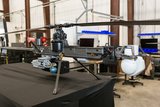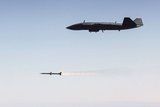Navy UCAS achieves milestone aboard Eisenhower
The Navy is one step closer to demonstrating the first carrier-based recoveries and launches of an autonomous, low-observable relevant unmanned aircraft.
Aboard USS Dwight D. Eisenhower (CVN-69) July 2, a team from the Navy Unmanned Combat Air System program office (PMA-268) accomplished the historical first carrier touchdown of an F/A-18D surrogate aircraft emulating an unmanned vehicle using systems developed as part of the Unmanned Combat Air System Carrier Demonstration (UCAS-D) program.
“What we saw here today is cutting edge technology for integrating digital control of autonomous carrier aircraft operations, and most importantly, the capability to automatically land an unmanned air system aboard an aircraft carrier,” said Capt. Jaime Engdahl, N-UCAS Program Manager. “Successfully landing and launching a surrogate aircraft allows us to look forward to demonstrating that a tailless, strike-fighter- sized unmanned system can operate safely in the carrier environment.”
Demonstrating the UCAS-D system with a proven carrier aircraft, the F/A-18D, significantly reduces risk of landing an unmanned system aboard the ship for the first time. The F/A-18 surrogate aircraft, provided by Air Test and Evaluation Squadron (VX) 23, is controlled with actual avionics and software that are being incorporated on X-47B UCAS-D aircraft.
“Surrogate testing allows us to evaluate ship systems, avionics systems, and early versions of the unmanned vehicle software with a pilot in the loop for safety,” said Glenn Colby, team lead for UCAS-D Aviation/Ship Integration. “With this we can verify our interfaces and functionality while minimizing the risk to an unmanned vehicle.”
Along with the F/A-18, the test team employed a King Air surrogate aircraft operated by Air-Tec, Inc. According to Colby, the King Air gives the team a low-cost test bed to evaluate the ability of the UCAS-D avionics and ship systems to properly adhere to existing carrier operations procedures. PMA-268 is using the King Air to test all of the system functionality that does not require actually landing on the ship.
“The most important thing we have done is adapted the ship’s systems to handle a vehicle without a pilot, then seamlessly integrated it into carrier operations,” said Rob Fox, UCAS-D Aviation/Ship Integration deputy team lead. “We’re using both current aircraft carrier hardware and software systems and processes, and introducing new systems and processes to accommodate an unmanned system.”
The vast majority of today’s carrier flight operations are flown manually and visually by Naval Aviators. The pilot gives the ship information about the aircraft over the radio; all air traffic control instructions are by voice and even a good portion of navigation data has to be read over the air by the ship. The purpose of the UCAS-D integration effort is to digitize the communications and navigation information flow to incorporate capabilities required for UAS flight operations aboard a carrier, with minimal impact to existing hardware, training and procedures.
“This test period shows us very clearly that the carrier segment hardware and software, and the Precision Global Positioning System (PGPS) landing technologies are mature and ready to support actual unmanned operations with the X-47B,” said Engdahl.
To support an autonomous vehicle, PMA-268 has modified shipboard equipment so that the UCAS-D X-47B air vehicle, mission operator and ship operators are on the same digital network. For current fleet aircraft, the Landing Signal Officer (LSO), who is charged with safe recovery of aircraft aboard the ship, uses voice commands and visual signals to communicate with a pilot on final approach.
Since a UAS cannot reliably respond to voice and visual signals, the LSO’s equipment communicates directly with the aircraft through the digital network via a highly reliable interface. Similar digital communication capability has been integrated with the ship’s primary flight control (“tower”) and Carrier Air Traffic Control Center (CATCC) facilities. Most importantly, the UAS operator’s equipment, installed in one of the carrier’s ready rooms, is integrated with the very same network.
In addition to communications, an unmanned system requires highly precise and reliable navigation to operate around the ship. Today’s first arrested landing of the F/A-18D surrogate aircraft aboard the Eisenhower was enabled by integrating Precision Global Positioning System (PGPS) capabilities into the ship and the aircraft.
According to Engdahl, these tests demonstrate that PGPS landing technologies and the carrier segment hardware and software are mature and ready to support actual unmanned operations with the X-47B. In addition, these capabilities have the potential to make manned aircraft operations safer and more efficient.
“Our team has worked vigorously over the past five years to modify and develop systems required to operate unmanned aircraft around and aboard a carrier,” said Adam Anderson, team lead for UCAS-D Aviation/Ship Integration System Build, who has worked on the program since 2006. “This was a very complex and challenging task that required innovative, hard-working and dedicated individuals to get the job done.”
The first experiments supporting unmanned carrier operations were conducted in 2002 followed by at-sea testing of a King Air in 2005. With the basic concept proven, the UCAS-D team began the detailed design of the carrier integration in 2007.
The PMA-268/NAVAIR team worked closely with experts from PEO (Carriers) and the Naval Sea Systems Command (NAVSEA) to determine the details of system installation on a carrier, while working to minimize impact to ongoing missions and capabilities aboard the ship. Initial capability of the ship equipment was verified in January 2010 during testing aboard the USS Abraham Lincoln.
In fall 2010, ship modifications began on the Eisenhower. The UCAS-D team worked closely with ship’s company personnel to lessen disruption to other activities required for normal operations and maintenance of the ship. Initial surrogate testing took place during the ship’s sea trials the week of June 13, which validated the system’s readiness for carrier landings.
“This was truly a team effort with our industry partners, including Northrop Grumman, Rockwell Collins, Honeywell, L-3 Communications, SAIC, ARINC and Sierra Nevada Corporation, PEO Carriers, NAVSEA and, of course, the crew of the USS Dwight D. Eisenhower,” Engdahl added. “The exceptional support and collaboration of the entire team has set us up very well to achieve our ultimate milestone –autonomous landing of an actual unmanned, low-observable relevant aircraft on the aircraft carrier in 2013.”
The UCAS-D program continues ship integration and X-47B flight test activities in preparation for sea trials in 2013. Flight testing is underway at Edwards Air Force Base and will transition to Pax River later this year.
Source: Naval Air Systems Command (NAVAIR)
More from Uncrewed Vehicles
-
![What's next for the Pentagon after the Replicator programme?]()
What's next for the Pentagon after the Replicator programme?
Although the Replicator initiative has made several accomplishments, there are still multiple gaps to plug across the US Department of Defense (DoD) and its services.
-
![Cummings Aerospace showcases Hellhound loitering munition designed for US Army’s LASSO programme (video)]()
Cummings Aerospace showcases Hellhound loitering munition designed for US Army’s LASSO programme (video)
Cummings Aerospace presented its turbojet-powered Hellhound loitering munition at SOF Week 2025, offering a man-portable solution aligned with the US Army’s LASSO requirements.
-
![SOF Week 2025: PDW unveils attritable FPV drone for SOF operations at scale]()
SOF Week 2025: PDW unveils attritable FPV drone for SOF operations at scale
PDW has revealed its Attritable Multirotor First Person View drone at SOF Week 2025, offering special operations forces a low-cost, rapidly deployable platform for strike and ISR missions, inspired by battlefield lessons from Ukraine.
-
![SOF Week 2025: Teledyne FLIR white paper provides guidance on reusable loitering munitions]()
SOF Week 2025: Teledyne FLIR white paper provides guidance on reusable loitering munitions
Teledyne FLIR is highlighting the emerging requirements for 'recoverable and re-usable' loitering munitions across the contemporary operating environment during this week’s SOF Week conference in Tampa, Florida.
-
![SOF Week 2025: Kraken Technology group debuts K3 Scout USV in North America]()
SOF Week 2025: Kraken Technology group debuts K3 Scout USV in North America
High-performance maritime industry player Kraken Technology Group, based in the UK, has used the SOF Week conference in Tampa, Florida this week to debut its K3 Scout uncrewed surface vessel (USV) to the North American market.
-
![Palladyne AI and Red Cat to demonstrate capabilities for autonomous drone swarms to the US military]()
Palladyne AI and Red Cat to demonstrate capabilities for autonomous drone swarms to the US military
Red Cat and Palladyne AI recently conducted a cross-platform collaborative flight involving three diverse heterogeneous drones.

























